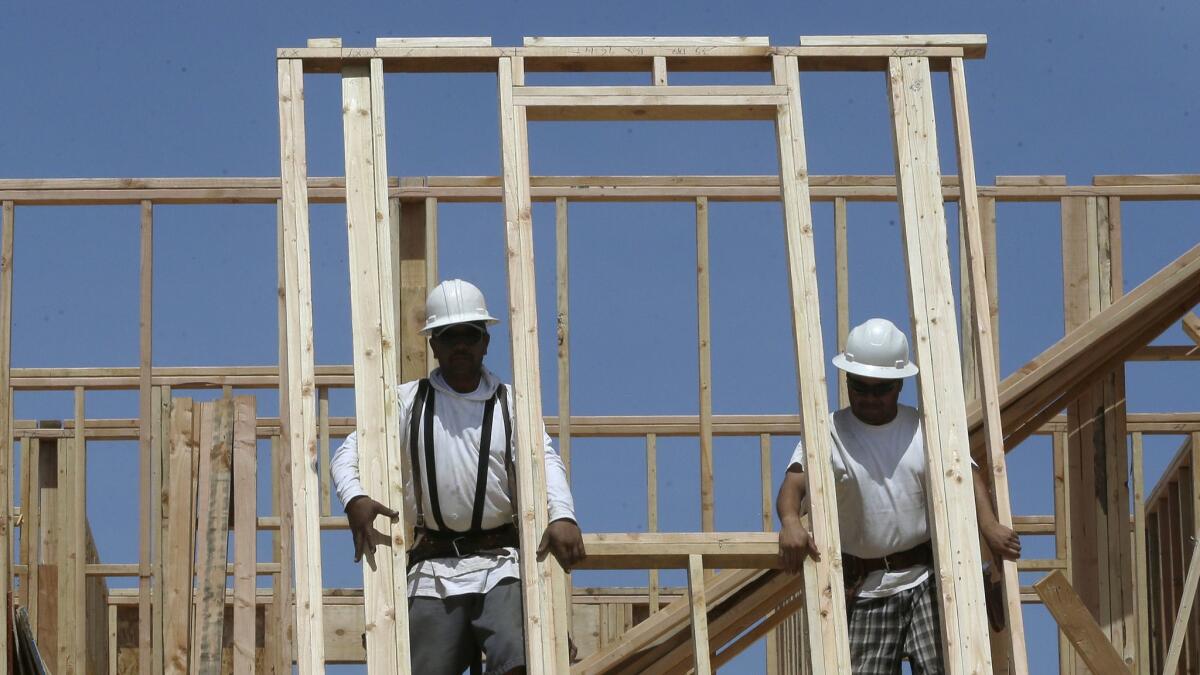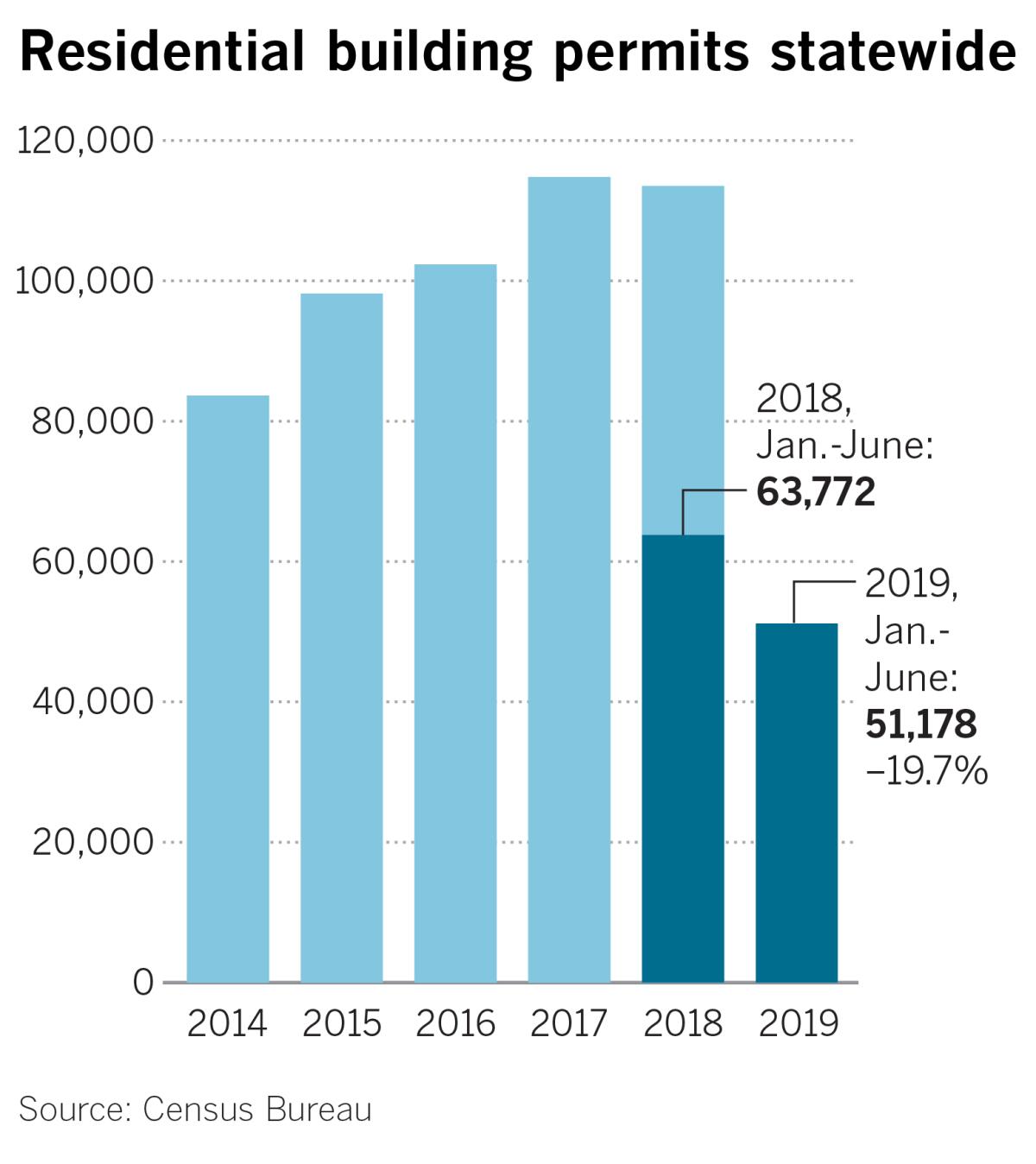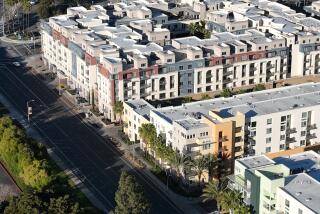California home builders are pulling back, deflating hopes for housing relief

Home builders are pulling back from new construction, the opposite of what economists say is needed to ease California’s housing affordability crisis.
In the first six months of 2019, builders gained approval for 51,178 new homes in California, nearly 20% fewer than the same period a year earlier. That puts the state on track for the first meaningful annual decline since the recession.
In the Los Angeles-Orange County metro area, total permits — an indication of future construction — fell by 25%, according to data from the U.S. Census Bureau. Single-family permits dropped 18.5% in the region, while those for multifamily projects such as apartment buildings -- a category in which activity tends to be more volatile -- fell 28.6%.
“We are going in exactly the wrong direction,” said Christopher Thornberg, founding partner of Beacon Economics.
Economists, developers and trade groups said the slowdown in permits has a simple explanation: It’s become harder to make money building homes.

Home prices and, to a lesser extent, rents, have softened as Californians find it harder to stretch their dollars and balk at stratospheric price points. Sales of existing and new homes have fallen, forcing some builders to cut prices on developments already underway.
In June, sales fell 8.8% in Southern California’s six counties. The median sales price was $541,250, up just 1.2% from a year earlier.
At the same time, construction costs are high and, by some measures, still rising. For new projects, builders said, there’s a limit to how low they can set prices or rents to stoke demand.
Builders cited the high costs for land, labor, materials and government fees, as well as tariffs on myriad building products and appliances. Over the last year, they said, the potential profit on many new projects has shrunk to the point at which it doesn’t make sense for builders or their financiers to take the risk.
“You can’t wish yourself into high rents and make a project feasible,” said Kevin Farrell, chief operating officer at apartment developer Century West Partners.
“No one is interested in doing loans to lose money,” said Scott Laurie, chief executive of Olson Co., which builds single-family and town homes throughout Southern California.
Last year, Laurie said, he walked away from a town home project Olson was planning in northern Orange County, giving up a $1-million-plus deposit, because construction costs jumped and he wasn’t confident potential buyers would pay a price that would make the deal pencil out.
According to John Burns Real Estate Consulting, costs for labor and materials rose 7.2% in June in Northern California compared with a year earlier, while home prices were essentially flat. In Southern California, costs rose 2.1% while prices increased 2%. In March, costs rose 4.1% while prices were flat.
Rick Palacios, director of research at John Burns, said developers are always cautious in a softening or declining market, fearful their projects won’t get filled. On top of that, the beginning of 2018 was a relatively strong time for housing construction, making the comparison with this year especially tough.
On the upside, Palacios said construction costs have shown signs of stabilizing. And some builders say lower mortgage rates have lured more people back into the market. The average rate on a 30-year fixed mortgage was 3.6% this week, down from 4.94% in November, according to Freddie Mac. The drop would save $314 a month if the buyer put 20% down on a $500,000 house.
In Los Angeles, developers have also flooded the city with proposals to build dense projects through a new program that loosened zoning and streamlined approval near mass transit lines. But many of those projects haven’t received approval or broken ground, and developers elsewhere still often face a lengthy approval process before they can build.
Even before sales slowed sharply over the last year, investors were focusing on deals with ready-to-build lots, or so-called entitled land, rather than projects that needed time-consuming government approvals to break ground. But now there are fewer lots ready to go and investors have grown even less optimistic, said Michael Marini, principal of developer Planet Home Living. “It’s worse now,” he said. “Everyone wants entitled land only.”
Permits have fallen nationally too, by 6% in the first half of the year. Thornberg, of Beacon Economics, said the decline is worse in California because the market has slowed the most on the most expensive homes, which fill much of coastal California.
He said it’s extremely difficult to build moderately priced housing in California, given high costs, tight environmental laws and neighborhood pushback that delays projects and drives up cost. He and other economists contend the main reason a 1,640-square-foot, 1920s-era house in Silver Lake sells for nearly $1.5 million is that for decades too few homes were built relative to population and job growth.
The slowdown in construction could shape some of the discussion about how to tackle the state’s housing crisis. Richard Green, director of the USC Lusk Center for Real Estate, said government should make it more profitable for private companies to build moderately priced homes by reducing fees and allowing more homes on individual lots.
Tenant groups have called for stricter rent control laws, viewing the private market as insufficient in tackling the crisis. Mark Vallianatos, policy director of advocacy group Abundant Housing LA, said government could also increasingly step in to subsidize projects or support nonprofit developers during a down cycle.
“We should use this slowdown as an opportunity to remove barriers to the traditional type of home building and also advance new ones,” he said.
When Kimberly Dominique received her Section 8 voucher in September, she thought it was the ticket to move out of the Ford Focus she and her 29-year-old son called home.
In places like Oregon, Nevada and Arizona, it’s far easier to build moderately priced housing, said Dan Dunmoyer, president of the California Building Industry Assn. As demand softens, he said, companies in those markets can keep building for longer and, in a downturn, return quicker.
Laurie, of Olson Co., said land sellers also have gotten a bit “more realistic” with their pricing, which could help more builders like him break ground. But it’s still hard to find places to build the $400,000-to-$650,000 homes the firm specializes in.
“We want the same thing as the affordable-home buyers — they want to buy an affordable home and we want to build it,” he said. “But right now there is a limited amount of land to build to those price points.”
More to Read
Inside the business of entertainment
The Wide Shot brings you news, analysis and insights on everything from streaming wars to production — and what it all means for the future.
You may occasionally receive promotional content from the Los Angeles Times.












